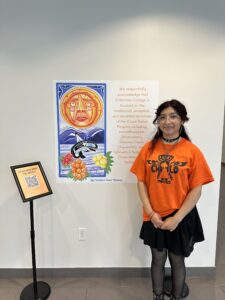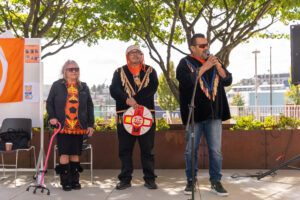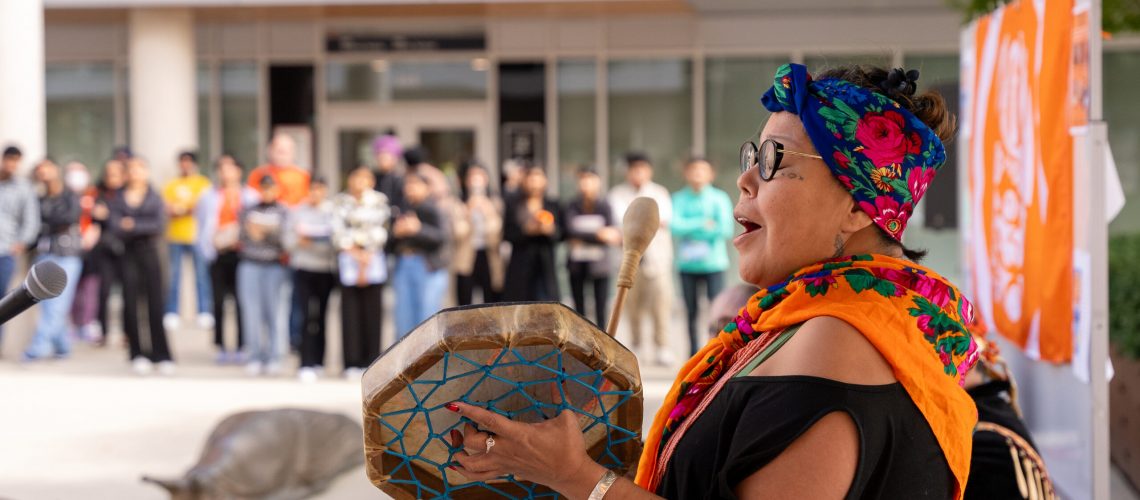
My name is Ana Maria Sabogal, and I’m an 18-year-old international student from Colombia, currently studying at Columbia College in Vancouver. I am pursuing my associate degree in general arts, with plans to further my studies in sociology. Growing up in Colombia, a country that has faced its struggles with conflict and violence, I believed I had a good understanding of trauma and injustice. However, in Canada, I was confronted with a history and present reality that I did not want to believe could happen on this side of the world.
My introduction to Truth and Reconciliation in Canada was, at first, accidental. During a visit to the Vancouver Art Gallery, I found a book titled On My Own Moccasins by Helen Knott. The memoir spoke of intergenerational trauma, racism, and gender violence experienced by an Indigenous woman in Canada. Although I didn’t have the chance to read it that day, I later found it at Columbia College’s library and finished it in one sitting. It was an intense experience that left me feeling hopeless and unsettled.
Learning about the violence against Indigenous women and the neglect faced by their communities was heartbreaking. The more I learned, the more I realized that this wasn’t just history; it’s still happening today. As I learned more through other books like Stolen Sisters by Emmanuel Walter and Highway of Tears by Jessica McDiarmid, I realized the real depth of the issues these communities face. Stories of missing and murdered Indigenous women and girls haunt me. I couldn’t help but compare this to what might happen if a white Canadian woman were to disappear. The media coverage and public outcry would likely be very different, but Indigenous families are left searching for answers on their own, often with little help from authorities.
For international students like myself, Truth and Reconciliation might seem like an issue for Canadians. But I believe it is important for all of us to understand the land we live on and the history we are a part of, even if our time here is temporary. Whether we plan to stay or return to our home countries, we are all part of this society while we are here. What we do and how we engage with these issues can make a difference.
The Role of Education and College
I have come to appreciate how important education is in reconciliation. Education isn’t just about learning facts; it’s about challenging our biases, asking difficult questions, and engaging with uncomfortable truths. At Columbia College, we are given the space to learn about these issues, whether through classes or events. One example is the Limitless Conference, which I participated in last winter. Listening to Indigenous speakers talk about how they are reclaiming their identity and culture after generations of harm was eye-opening. These conversations helped me understand not only the past but the ongoing efforts Indigenous communities are making to heal. The Truth and Reconciliation events organized from September 23 to 27 deepened my understanding. I learned that true reconciliation involves the active participation of all parties involved and that making progress also involves talking about the trauma.

Beyond that, my volunteer work at the Vancouver Women’s Health Collective has also allowed me to engage with these issues more hands-only. During Missing and Murdered Indigenous Women and Girls (MMIWG) Day, we organized events. We put up posters, but the most impactful were our conversations about creating a safe space for Indigenous women at the center. We discussed how to ensure women who come to the center feel supported, seen, and respected. These are small steps, but they are part of the larger effort to ensure that Indigenous women are no longer ignored or marginalized.
While seeing more awareness around Truth and Reconciliation is encouraging, the challenges are still immense. One of the most significant problems is that the Canadian government has not followed through on many of the 94 Calls to Action by the Truth and Reconciliation Commission. Only a few have been completed, and much of the burden of reconciliation is still placed on Indigenous communities themselves. The government and society as a whole need to take more responsibility for the harm caused by the residential school system and ongoing systemic discrimination.
We see this in the way Indigenous people are often treated in Canadian society, from healthcare to education to how the justice system handles their cases. If we think of residential schools as something of the past that has already ended, then we are leaving these communities to bear the weight of that trauma.
What We Can Do
One of the key things I’ve learned is that reconciliation starts with each of us as individuals. We need to examine our own biases and assumptions, whether they relate to Indigenous peoples, homelessness, or addiction. For example, while Indigenous peoples make up only 4.3% of the Canadian population, they represent 28-34% of the homeless shelter population. If we become aware of how our everyday actions or attitudes may contribute to these inequalities, we can begin to challenge the harmful stereotypes that perpetuate these issues.


